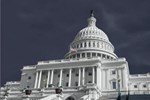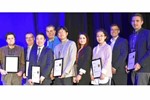PHOTONICS CAREER DEVELOPMENT NEWS
-
SPIE Launches Peer-Review Training Course
The new SPIE peer-review training course offers a comprehensive, interactive blend of online learning and hands-on peer review experience.
-
Scientists Say U.S. Must Raise Investments, Develop Workforce To Lead Quantum Computing Race
Representatives from government, academe, and industry say the United States should strengthen collaboration, increase funding, and build an interdisciplinary workforce who will develop photonics-enabled quantum technologies, which will be critical to the country's global competitiveness and security in the near future.
-
Aspiring Photonics Entrepreneurs Invited To Apply For SPIE Startup Challenge
Aspiring entrepreneurs have until 16 November to apply for an opportunity pitch their light-based technology product ideas to a team of business development experts and venture capitalists — and win a share of more than $85,000 in cash, prizes, and support in the SPIE Startup Challenge 2018.
-
Innovation-Driving Research, Applications To Take Center Stage At SPIE Photonics West 2018
Talks by two Nobel Laureates will be among more than 5,200 leading-edge technical presentations held alongside the premier global photonics and laser exhibition, seminars, and training courses at SPIE Photonics West 2018 in San Francisco, California.
-
Outstanding Early-Career Work Eligible For SPIE Rising Researcher Awards
Early-career professionals who are conducting outstanding work in product development or research in defense, commercial, and scientific sensing, imaging, optics, or related fields are invited to apply for Rising Researchers awards in a program offered by SPIE, the international society for optics and photonics.
PHOTONICS CAREER DEVELOPMENT WHITE PAPERS AND APPLICATION NOTES
-
Traditionally, laser operators only verify a laser’s average power or energy to improve efficiency and, if everything is in order, put their laser back into service. This article discusses steps required to identify and use a camera profiling system (arrayed camera, attenuator, and beam dump) for laser management.
-
Thermal imaging is simply made up of a thermal scene, a lens, a sensor, and a display. But how do you focus heat? What kind of sensor detects heat, and how do you display it? This article offers a short Infrared 101 overview, and covers fundamental terms and concepts of thermal imaging.
-
Understanding and manipulating the polarization of light is crucial for many optical applications. Optical design frequently focuses on the wavelength and intensity of light, while neglecting its polarization. Polarization, however, is an important property of light that affects even those optical systems that do not explicitly measure it. The polarization of light affects the focus of laser beams, influences the cut-off wavelengths of filters, and can be important to prevent unwanted back reflections. It is essential for many metrology applications, such as stress analysis in glass or plastic, pharmaceutical ingredient analysis, and biological microscopy.
PHOTONICS CAREER DEVELOPMENT GUEST COLUMNS
-
Microlearning Applied To Laser Safety
This article explains the concept and demonstrates how the training approach known as “microlearning” can be applied in laser use settings to the advantage of staff, researchers, and management.
-
Properly Executing Fiber Optic Safety
Happily, laser accidents with fibers are almost exclusively related to non-beam hazards. Still, laser fiber users need to understand a number of factors relevant to fiber optic safety.
-
Understanding Laser Safety In Fabrication Settings
Many laser standards exist to address the variety of laser use applications, but the fabrication setting is conspicuously omitted. This article details what the basic laser safety requirements for fabrication, as well as what it takes to implement such safeguards.
-
A Guide To Selecting Laser Protective Eyewear
When it comes to laser protective eyewear, a number of factors go into selecting the best option, and some are more important than others.
PHOTONICS CAREER DEVELOPMENT INTERVIEWS
-
Visualizing Growth In Hyperspectral Imaging: A Q&A With TruTag CTO Hod Finkelstein
Dr. Finkelstein discussed with Photonics Online how his experience in the medtech and RF industries helped inform decisions when creating new HSI technologies. He offered insight into maintaining balance in the growth of both optical and data processing technologies for HSI, and discussed development of TruTag’s Prism Award-winning hyperspectral imaging solution.
-
A Q&A With Dr. Brian Pogue, Incoming Editor-in-Chief, SPIE Journal of Biomedical Optics
Dr. Brian Pogue of Dartmouth College will take the helm as editor-in-chief of SPIE’s Journal of Biomedical Optics (JBO) starting Jan. 1, 2018. Pogue spoke with Photonics Online about his decision to join the JBO as editor-in-chief, his vision for the journal, and how he balances all of his interests in limited time.
-
Q&A With SPIE CEO Dr. Eugene Arthurs
In July, SPIE CEO Dr. Eugene Arthurs announced his intent to retire effective on Jan. 19, 2018. Recently, Dr, Arthurs graciously made time to reflect on his career at SPIE, as well as his and the organization’s future, with Photonics Online.









